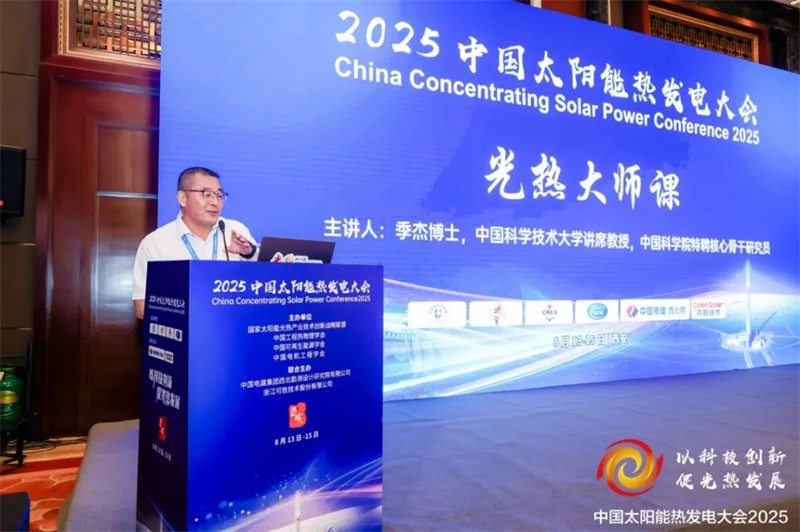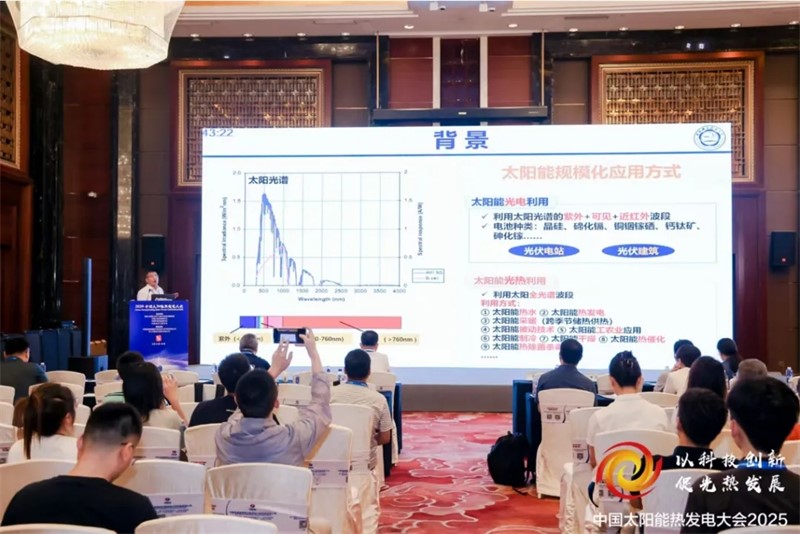On 14 August, at the 2025 China CSP Conference, the inaugural “CSP Master Class” became the talk of the industry. For the first time in the conference’s 19-year history, a systematic, academic course was offered. The lecturer was Prof. Ji Jie, Chair Professor at the University of Science and Technology of China (USTC) and Core Researcher of the Chinese Academy of Sciences. In 45 minutes he built a coherent framework for “decoupled solar photo-electric-thermal multi-effect utilization.” After the session, the CSTA sat down with Prof. Ji for an in-depth conversation to uncover the deeper meaning behind this “first lesson” for the sector.

Why launch the course? Three starting points aimed squarely at industry pain points.
The China CSP Conference originated in 2007 as the “Sanya International Forum on CSP Technology” and has since become China’s most authoritative and influential solar-thermal event, driving technology and industry progress both domestically and worldwide.
“This year we introduced the course to solve the problem of ‘knowing how, but not why’,” Prof. Ji said bluntly. After years of development, many practitioners are adept at engineering tasks yet lack systematic understanding of basic concepts and theory—directly limiting innovation and problem-solving efficiency.
The curriculum was designed around three objectives:
• Solidify the fundamentals: deepen understanding of basic solar-energy concepts and principles—e.g., solar-radiation calculation and heat-transfer mechanisms. “Without solid foundations, applications are castles in the air.”
• Expand boundaries: explore new applications beyond CSP, such as solar water purification, building-integrated systems, and PV-thermal synergy. “Don’t focus only on ‘selling power’; see the wider landscape.”
• Emphasize methodology: highlight theoretical modeling and “decoupling” thinking. “Light, electricity and heat are three convertible forms of solar energy; they can be coupled or used separately. Mastering decoupling methods allows precise system optimization and stronger R&D capabilities.”
Ultimate goal: enable researchers and engineers to solve real problems more scientifically. “If you understand heat-transfer mechanisms, you can quickly identify whether an efficiency drop is due to conduction, convection or radiation.”
45 minutes to unpack “photo-electric-thermal”: balancing rigor and practicality
Spanning three domains—light, electricity and heat—how could the course benefit listeners with diverse backgrounds? Prof. Ji’s answer: “layered design, simple to advanced.”
The first half focused on fundamentals: solar-radiation geometry, the three heat-transfer modes (conduction, convection, radiation) and the PN-junction physics of photovoltaics—“internal skills that save everyone detours.” When discussing solar-radiation calculations, he combined equations with real scenarios: “Only by knowing latitude and solar altitude can you design optimal collector tilt angles.”
The second half pivoted to practice and innovation—how to build coupled photo-electric-thermal models and concrete cases of multi-effect utilization:
• How phase-change materials (PCM) can cool PV panels while storing heat for night use.
• How PV façades can generate power, heat buildings and purify air simultaneously.
• How concentrating photovoltaic (CPV) plus thermoelectric generation (TEG) can double energy-utilization efficiency.
“Theory is the skeleton; case studies are the flesh.” Prof. Ji stressed that formulas are not to be memorized but understood: “When we teach the single-diode model, the goal is to grasp how temperature affects PV efficiency so you can improve performance via temperature control.”
From “problem solving” to “mind opening”: what the course brings the industry
“For newcomers, it’s a gateway; for veterans, a mind-refresh,” Prof. Ji summarized.
For engineers and corporate staff, mastering photo-electric-thermal mechanisms enables targeted actions: avoiding indoor overheating in PV-building design; decoupling optical, electrical and thermal paths in CSP plants to boost both conversion efficiency and storage capability.
For advanced professionals, the course offers cutting-edge research that broadens horizons. Prof. Ji’s team leads globally in multi-effect solar utilization:
• Their PCM-PVT system raises electrical efficiency by 5.36 % and thermal efficiency by 5.2 %.
• A “thermo-catalytic PV wall” can degrade formaldehyde while providing space heating, achieving a 49.8 % purification rate in a single pass.
“These are not lab curiosities but deployable solutions.” PV-thermal-integrated buildings that generate power, deliver heating/cooling and purify air exemplify the appeal of “multi-effect utilization.”
More importantly, the course pushes the industry beyond single-purpose mind-sets. Solar energy should not be confined to “electricity” or “hot water.” When it is also used for seawater desalination, industrial drying and medical sterilization, the entire sector can flourish.

Future outlook: interdisciplinary fusion to “heat up” the CSP industry
Looking ahead, Prof. Ji is enthusiastic. The conference’s new formats—dialogue sessions, debates, master classes—are exactly the “out-of-the-box” attempts the sector needs. Solar energy is inherently interdisciplinary: researchers must understand engineering, enterprises must understand policy, and policymakers must understand technology—only then can synergy emerge.
He hopes future courses will become more interactive: “Companies can bring real problems, and we’ll dissect them using theoretical models; experts from different fields can debate, say, PV vs. CSP building integration, sparking new ideas.”
Prof. Ji’s message to the industry: solar-thermal is not a niche technology; it is a key force for achieving carbon-peaking and carbon-neutrality goals. May this course be a starting point for more people to truly grasp the potential of solar energy—wherever sunlight reaches, infinite possibilities await.


